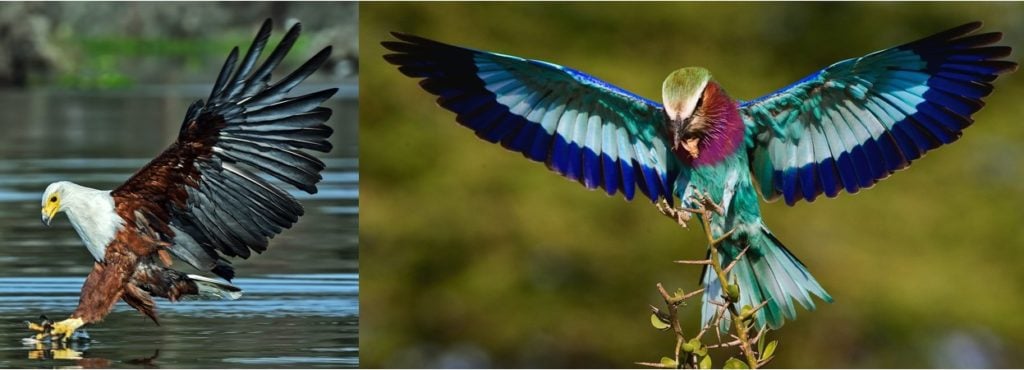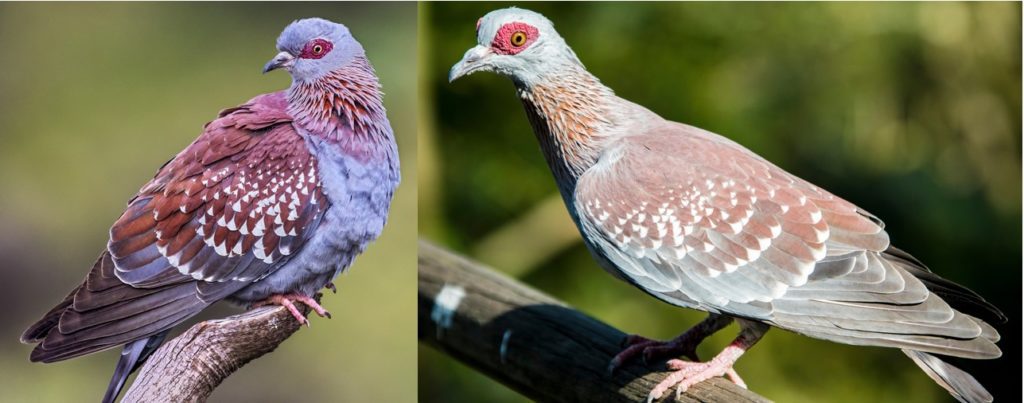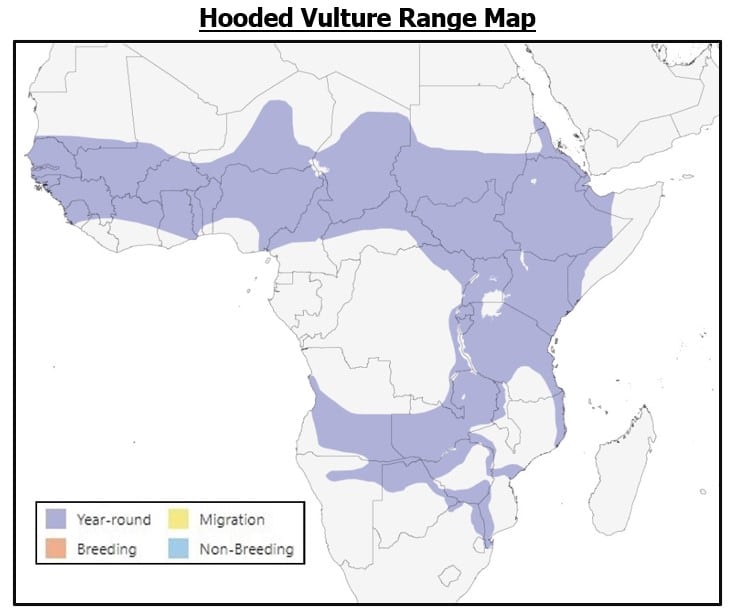14 COMMON Birds Found in Sudan! (2025)
Are you trying to identify a bird found in Sudan?

Some of the wildest and most colorful birds you could imagine are found here. From gigantic, flightless birds to colorful showstoppers, there’s something to catch everyone’s attention!
Due to the sheer number of species, there was no way to include every bird in Sudan in this article. So instead, I tried to focus on the birds that are most regularly seen and observed.
14 COMMON types of birds in Sudan!
#1. Abyssinian Roller
- Coracias abyssinicus

Identifying Characteristics:
- Adults are 28–30 cm (11–12 in) long.
- The butterscotch brown back and face contrast sharply with its otherwise brilliant blue plumage.
- They have two unusually long tail feathers that look like streamers in flight.
The Abyssinian Roller is an unmistakably beautiful bird in Sudan!
However, its appearance is just one of its many incredible traits. For example, check out their attack pattern, which is how they earned their name. They tumble and roll as they try to catch escaping prey.
Abyssinian Rollers fly through forests decimated by fire, looking for disturbed rodents, snakes, invertebrates, and reptiles to hunt. They’re also aggressive at defending their territory. They juke and somersault, dive-bombing humans or other threats.
Although unrelated to corvids, these flashy birds make a crow-like sound of “GawwwK” or a screechy “Arrrg.” These mimicking sounds are deliberately intimidating, and this fearless species has the personality to back them up. LISTEN BELOW!
#2. African Sacred Ibis
- Threskiornis aethiopicus

Identifying Characteristics:
- Adults are 68 cm (27 in) long with a wingspan of 112-124 cm (44-49 in).
- Their plumage is white overall, with black wing tips and tail feathers.
- The head and legs are black and featherless, and the beak is very long and curved downward.
The Sacred Ibis was integral to ancient Egyptian religious ceremonies. Unfortunately, it’s now locally extinct in Egypt. However, it is still widespread in Sudan.
Its long scythe-like beak cuts through vegetation in marshes, swamps, and along riverbanks. It pokes in the muddy bottoms of small water bodies as it forages and visits mud flats far inland in search of food. You may even see them in garbage dumps, pasturelands, and freshly plowed fields, looking for earthworms.
The African Sacred Ibis has a variety of sounds, from a call similar to a yappy dog to a long, loud honk. This call, a long chirping noise, is one of their most common.

#3. Beautiful Sunbird
- Cinnyris pulchellus

Identifying Characteristics:
- Adults are 10 cm (4 in) long.
- Males are black on the face and belly, with metallic green on the head, back, and underparts. The chest is a vibrant red, bordered with bright yellow.
- Females are brown, with yellow-brown underparts.
These colorful, flashy birds in Sudan feed primarily on nectar, like the hummingbirds of the western hemisphere. They like to feed upside down, hanging from a branch to get to inverted flowers. This position can make them look a little like a traffic light. Beautiful Sunbirds have a tubular tongue with a brush-like tip to aid in nectar collection.
Hotel proprietors often plant their preferred flowers to attract them to entertain visitors. Their vivid coloring and vocal nature make them a true joy to watch!
The Beautiful Sunbird’s song is a chu-chu-chu repeated in triplets or irregular groups and at irregular intervals.
#4. Common Ostrich
- Struthio camelus

Identifying Characteristics:
- Adults stand up to 2.8 meters (9 feet) tall and can weigh 154 kg (340 lbs).
- Their plumage is dark on the body, with white wings and tail tips. Males are black, and females are brown.
- The long legs and neck are buff to pinkish, sometimes with pale downy feathers. They have large feet with sharp talons and small heads.
The Common Ostrich is not only the largest bird in Sudan but also worldwide!
But that’s not the only reason this giant species is remarkable. They can run at over 70 kph (43 mph), and their kick is powerful enough to kill a lion! Interestingly, all this athletic prowess is for survival only since Ostriches are predominantly herbivores. They eat the occasional lizard but prefer fruit, seeds, and grasses.
During the breeding season, they form harems of one male and between two and seven females. Then, they raise their young as a community. Each female can produce up to nine offspring, so this village is particularly important!
You might think Ostriches look practically prehistoric, and you’d be right! The lower parts of their legs are scaled for protection, as was typical for their dinosaur ancestors.
#5. Hamerkop
- Scopus umbretta

Identifying Characteristics:
- Adults stand about 56 cm (22 in) tall.
- Brown all over, with a dark brown to black bill and legs.
- This waterbird has an unusual crest, making its head appear elongated toward the back.
You might have seen pictures of the Hamerkop on its favorite perch – the back of a hippopotamus! This water bird likes to hunt from these living platforms, and the hippos don’t seem to mind.
An easy way to identify this bird in Sudan is to look for its incredible nest. They build a huge nest (up to two meters tall) in a tree fork, with only a tiny side entrance. The same nest can be used for up to four years unless it is disturbed in some way, which happens more often than you might think.
They’re also rather noisy, cackling and yapping while they hunt and socialize.

#6. Hooded Vulture
- Necrosyrtes monachus

Identifying Characteristics:
- Adults are 62–72 cm (24–28 in) long with a wingspan of 155–180 cm (61–71 in).
- Their plumage is a uniform brown, with a featherless pinkish-white face and a grey-brown “hood” of short feathers.
- This large vulture has an upright posture, large body, and small head, which are typical of its kind.
The Hooded Vulture is more mild-mannered than most other scavengers in Sudan.
As a result, it’s developed skills to make sure they can eat before more aggressive vultures chase it off from a carcass. It often arrives first, takes a small meal, and moves on, eating more frequently and in smaller portions.
Another way this species has adapted is to start visiting slaughterhouses and garbage dumps. Here, they take advantage of easy meals. The clever part is that the bigger, more aggressive vultures are not comfortable around humans, so Hooded Vultures avoid conflict.
Despite finding ways to adapt and survive, Hooded Vultures are still considered critically endangered. Often, when poachers kill big game, they remove the valuable parts and then poison the carcass with pesticides. These toxins kill any vultures that come to feed, so rangers won’t see vultures circling the carcasses, and the criminals have more time to get away.
#7. Little Bee-Eater
- Merops pusillus

Identifying Characteristics:
- Adults are 15–17 cm (6-7 in.) long.
- They have a green back, a bright yellow throat, and a black collar. Their bellies are a deeper brownish-yellow.
- This species is slender and upright, with a pointed black beak.
Little Bee-eaters are the smallest species of African bee-eater. These birds are quite tame and friendly. They make practically no sound except for a quietly trilled “s-s-e-e-e-p.”
As their name implies, these little birds subsist on hornets, wasps, and bees. But, they’ve found an efficient way to avoid being stung by their favorite foods. Before they eat them, they smash their prey’s stinger into a hard surface several times to extract it.
Look for groups of Little Bee-eaters lined up, roosting communally on a branch. These tight-knit communities spend time together year-round. For example, a non-breeding pair will help feed chicks and even sit on the eggs to help out. Some nesters can have as many as five helpers raising the nestlings.
#8. Marabou Stork
- Leptoptilos crumenifer

Identifying Characteristics:
- Adults reach heights of 152 cm (5 feet) and have a wingspan of 3.7 m (12 ft).
- Its back and wings are black, with a white underside and bald, pinkish-white head and neck.
- This species is very large, with a pelican-like shape, huge bill, and long legs.
The Marabou Stork is the largest carrion bird in Sudan!
This gigantic species stands taller than some adult humans and has an incredibly large wingspan.
Look for these birds, also called “Undertaker Birds”, circling above carcasses or garbage dumps. They fly with their neck retracted but keep their feet out, using them as a steering rudder. They occasionally take live prey, including flamingo chicks and crocodile hatchlings.
#9. Pied Crow
- Corvus albus

Identifying Characteristics:
- Adults are 46-52 cm (18-20 in) long.
- Their coloring is completely black, except for the stark white “vest” between their wings and across their chest.
If you’ve ever wondered about the difference between a crow and a raven, studying the Pied Crow is a good way to learn! This bird in Sudan is considered a “link” between the two related families. It has the larger bill and long legs of a raven, as well as wider wings and a longer tail. However, its beak is small and straight like a crow’s, and it also has the typical “caw” call.
Pied Crows are often found near humans, but they don’t interact with people very much. They seem to like villages and towns, probably because of the abundance of food due to human refuse.
They are social and may congregate near an abundance of food but are generally found in pairs or small groups. Pied Crows eat reptiles and mammals, nestlings and eggs, insects and invertebrates, peanuts, grains, carrion, and human trash. If there is a slaughterhouse in the vicinity, you’ll almost certainly find them there, too.
#10. Speckled Pigeon
- Columba guinea

Identifying Characteristics:
- Adults grow up to 41 cm (16 in) long.
- Their coloring is slate gray overall, with rusty wings and white tips on the flight feathers.
- They have a ring of red skin around the eye, giving them a wide-eyed look.
It’s not uncommon for hundreds of Speckled Pigeons to form a flock and inhabit the exterior of large human structures. They’re the primary food source for birds of prey that live in large cities.
Although their shape and behavior are similar to typical urban rock pigeons, Speckled Pigeons are much larger. This species is the largest pigeon in Sudan at nearly 41 cm (16 inches) long.
Even if the Speckled Pigeon’s call is understated and melodic, it can be overwhelming when hundreds are singing at once. It sounds like “OooOOOuu” repeated a dozen times or more in a row.

#11. Village Weaver
- Ploceus cucullatus

Identifying Characteristics:
- Adults are 15–17 cm (6-7 in) long.
- Males have a black face with a bright red eye, a bright yellow chest, a brown cowl down the back of the head, and splotchy black and yellow wings.
- Females are largely yellow (including the head), with pale olive stripes on the upper parts and buff-yellow chest and underparts.
The Village Weaver has some of the most interesting nesting habits of any bird in Sudan.
For one, the nests themselves look like Christmas ornaments! They’re woven balls of grass and feathers that hang from the branches of trees. Additionally, male Village Weavers build the nests alone and defend them to attract a mate. Think of this as showing off your big, new house to your date!
Once a female chooses a nest (and a mate), she fills it with bedding and lays her eggs. Then, the male finds another mate and begins the process again! Despite having up to five broods at a time, the male Village Weaver contributes to the feeding and care of all his hatchlings.
These communal birds can be quite noisy, as they spend most of their time in their nests calling to one another.

#12. Woodland Kingfisher
- Halcyon senegalensis

Identifying Characteristics:
- Adults grow to 23 cm (9.1 in) long.
- Its wings and back are electric blue, with black patches on the wings and a white chest and neck.
- This species’ beak is large for its body, brilliant orange on top and black below.
The really interesting thing about kingfishers is you can instantly tell whether they live on fish or insects by the color of their beaks! As with the Woodland Kingfisher, orange beaks indicate an insect diet, and other colors like black or blue mean a fish-heavy diet.
Woodland Kingfishers are unusual because they can mimic other birds with the way they stand. When they squat and puff out their feathers, they tend to look like a sparrow, and if they stand taller, they are more like a robin. Females stand up tall more often to advertise to a potential mate. They also spread their wings wide to appear as large and colorful as possible.
The sound of their song is usually one sharp note, a pause, then about 20 trills of a descending note.

#13. White-backed Vulture
- Gyps africanus

Identifying Characteristics:
- Adults are 78-98 cm (31-39 in) long and have a 1.96-2.25 m (6-7 ft) wingspan.
- Its coloring is muted brown, except for its off-white back. The face and wings are darker brown than the body.
- This species has a bald face and short, downy feathers on the head and neck.
This species has seen the most rapid decline of any bird in Sudan.
Its conservation status has gone from Least Concern to Critically Endangered in just fifteen years. Power lines, poisoned carrion, pesticides, and poaching are also contributing factors.
Part of the reason for their decline is that White-backed Vultures are very tame and will happily wander into town to look for food. Unfortunately, it’s vulnerable to kidney failure due to poisoning from diclofenac, a drug widely used by humans for pain, inflammation, arthritis, and gout.
In addition to diclofenac poisoning, fires have recently eliminated much of their breeding territory, adding to the decline. Their extremely long breeding cycle is another strain on their population. White-backed Vultures have to incubate their eggs for two months and care for nestlings for four to five months.
#14. Pin-Tailed Whydah
- Vidua macroura

Identifying Characteristics:
- Adults are 12–13 cm (4-5 in) long, but males have exceptionally long tails – up to 20 cm (8 in)!
- Males are black on the back, head, and wings, with a white belly and throat.
- Females are light brown with black streaks.
- Both sexes have a short, conical, red-orange beak.
Look for Pin-tailed Whydahs in grassland habitats. It’s a common bird in Sudan south of the Sahara.
This species is considered a brood parasite, meaning the female lays her eggs in the nest of other species. Then, once the eggs hatch, the mother takes care of the Pin-tailed Whydah hatchlings along with her own.
Unlike some other brood parasites, the Pin-Tailed Whydah doesn’t destroy the host bird’s eggs, which means other species can still thrive alongside it.
Do you need help identifying birds in Africa?
These books will provide you with much more information!
Which of these birds in Sudan have you seen before?
Leave a comment below!














